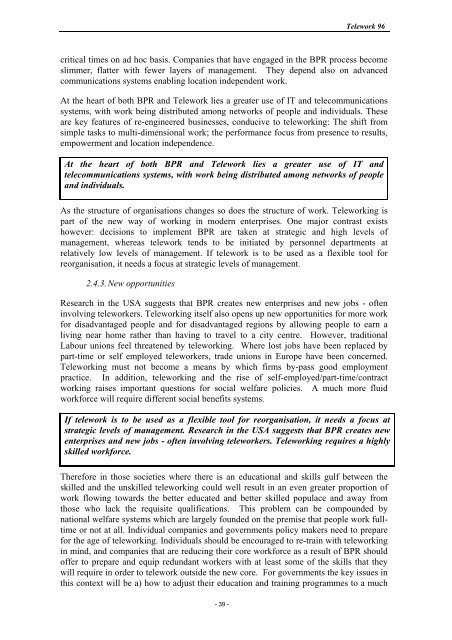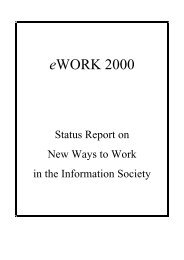1996 - European Telework Week
1996 - European Telework Week
1996 - European Telework Week
- No tags were found...
You also want an ePaper? Increase the reach of your titles
YUMPU automatically turns print PDFs into web optimized ePapers that Google loves.
<strong>Telework</strong> 96<br />
critical times on ad hoc basis. Companies that have engaged in the BPR process become<br />
slimmer, flatter with fewer layers of management. They depend also on advanced<br />
communications systems enabling location independent work.<br />
At the heart of both BPR and <strong>Telework</strong> lies a greater use of IT and telecommunications<br />
systems, with work being distributed among networks of people and individuals. These<br />
are key features of re-engineered businesses, conducive to teleworking: The shift from<br />
simple tasks to multi-dimensional work; the performance focus from presence to results,<br />
empowerment and location independence.<br />
At the heart of both BPR and <strong>Telework</strong> lies a greater use of IT and<br />
telecommunications systems, with work being distributed among networks of people<br />
and individuals.<br />
As the structure of organisations changes so does the structure of work. <strong>Telework</strong>ing is<br />
part of the new way of working in modern enterprises. One major contrast exists<br />
however: decisions to implement BPR are taken at strategic and high levels of<br />
management, whereas telework tends to be initiated by personnel departments at<br />
relatively low levels of management. If telework is to be used as a flexible tool for<br />
reorganisation, it needs a focus at strategic levels of management.<br />
2.4.3. New opportunities<br />
Research in the USA suggests that BPR creates new enterprises and new jobs - often<br />
involving teleworkers. <strong>Telework</strong>ing itself also opens up new opportunities for more work<br />
for disadvantaged people and for disadvantaged regions by allowing people to earn a<br />
living near home rather than having to travel to a city centre. However, traditional<br />
Labour unions feel threatened by teleworking. Where lost jobs have been replaced by<br />
part-time or self employed teleworkers, trade unions in Europe have been concerned.<br />
<strong>Telework</strong>ing must not become a means by which firms by-pass good employment<br />
practice. In addition, teleworking and the rise of self-employed/part-time/contract<br />
working raises important questions for social welfare policies. A much more fluid<br />
workforce will require different social benefits systems.<br />
If telework is to be used as a flexible tool for reorganisation, it needs a focus at<br />
strategic levels of management. Research in the USA suggests that BPR creates new<br />
enterprises and new jobs - often involving teleworkers. <strong>Telework</strong>ing requires a highly<br />
skilled workforce.<br />
Therefore in those societies where there is an educational and skills gulf between the<br />
skilled and the unskilled teleworking could well result in an even greater proportion of<br />
work flowing towards the better educated and better skilled populace and away from<br />
those who lack the requisite qualifications. This problem can be compounded by<br />
national welfare systems which are largely founded on the premise that people work fulltime<br />
or not at all. Individual companies and governments policy makers need to prepare<br />
for the age of teleworking. Individuals should be encouraged to re-train with teleworking<br />
in mind, and companies that are reducing their core workforce as a result of BPR should<br />
offer to prepare and equip redundant workers with at least some of the skills that they<br />
will require in order to telework outside the new core. For governments the key issues in<br />
this context will be a) how to adjust their education and training programmes to a much<br />
- 39 -








